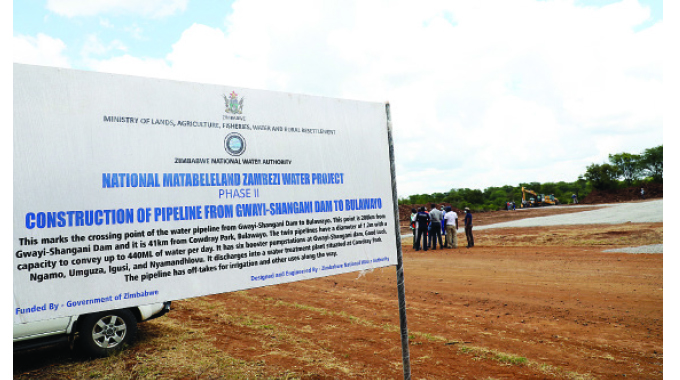Government speeds up construction of Gwayi-Shangani Lake Pipeline in Byo
The Chronicle
Nqobile Tshili, columnist
The GOVERNMENT has increased the number of contractors who will lay the 245km pipeline from Lake Gwayi-Shangani to Bulawayo to eleven to ensure water is pumped to the city by the end of this year.
Initially, six contractors were awarded the contract.
Each contractor was given at least 21 km to work.
Construction of Lake Gwayi-Shangani is among the government’s top priorities and is expected to be completed this year after missing last year’s deadline.
Zinwa contracted a Chinese company to build the dam with a holding capacity of 650 million cubic meters.
This is part of the Matabeleland Zambezi National Water Supply Project (NMZWP) to bring water from the Zambezi River to Bulawayo to permanently solve the city’s water problems.
The Minister of Lands, Agriculture, Water, Fisheries and Rural Development, Dr Anxious Masuka visited Lake Gwayi-Shangani yesterday to assess the progress made so far.
After the tour, he said he was confident that by December, Bulawayo would draw water from Lake Gwayi-Shangani in accordance with the set deadlines.
“Progress has been made and Zinwa told us that the dam wall is now 90 meters high but cannot start holding water now as they do not want to interrupt the water supply works.
But they will do it at the end of February and we will have 20 million cubic meters to be able to supply them when we want,” said Dr Masuka.
He was confident that the surveying of how the pipeline will travel along the rail line had begun and that the laying of the pipeline would create jobs for locals.
“Eleven contractors will likely be on site by March so that we can complete all work in time for commissioning by December.
Treatment work at Cowdray Park is said to have been carried out.
Each of the 11 contractors has 21 km to cover and they will be able to employ locals as this is civil engineering work.
We won’t know the numbers until the contractors are on site, but it will have a significant local economic impact,” Dr Masuka said.
He said the government will create an irrigation green belt along the Gwayi-Shangani-Bulawayo pipeline, which will trigger rural industrialization.
The irrigated perimeters will belong to the community and the Agricultural Rural Development Agency (Arda) will manage them.
He said that the first beneficiaries of the irrigated perimeters are those who will be displaced due to the scale of the project works.
“We also had the opportunity to discuss in detail the proposed irrigation, which will be of two types.
The first will be a Vision 2030 accelerator model where we envision something similar to the Bubi-Lupane irrigation system.
We would look at five different sites and the first is around the dam where there is going to be a displacement of 400 to 700 families.
These households will become the first beneficiaries of the irrigation that is going to take place,” he said.
“As we bring water to Bulawayo, we now have five pumping points at which we will irrigate.
We envision at least 200 hectares for each pump station again using the Vision 2030 accelerator model, which will be co-managed by Arda for the benefit of the community leading to rural development to facilitate the achievement of Vision 2030.”
He said a fishing project will also be launched along the pipeline for the benefit of the communities.
Dr. Masuka said that in accordance with the dam construction plan, a hydroelectric power station will be constructed at the site of the dam.
“We looked at the power generation and the options available and they started trenching.
Thus, work is progressing to our satisfaction and we will be well on our way to commissioning and delivering water to Bulawayo alongside the development of irrigation here and along the way as well as the production of water. ‘electricity,’ Dr Masuka said.
“I am very pleased with the progress made by Zinwa and the rest of the team.
We are committed to inviting all relevant ministries and departments during our next visit to better coordinate the implementation. – @nqotshili


Comments are closed.